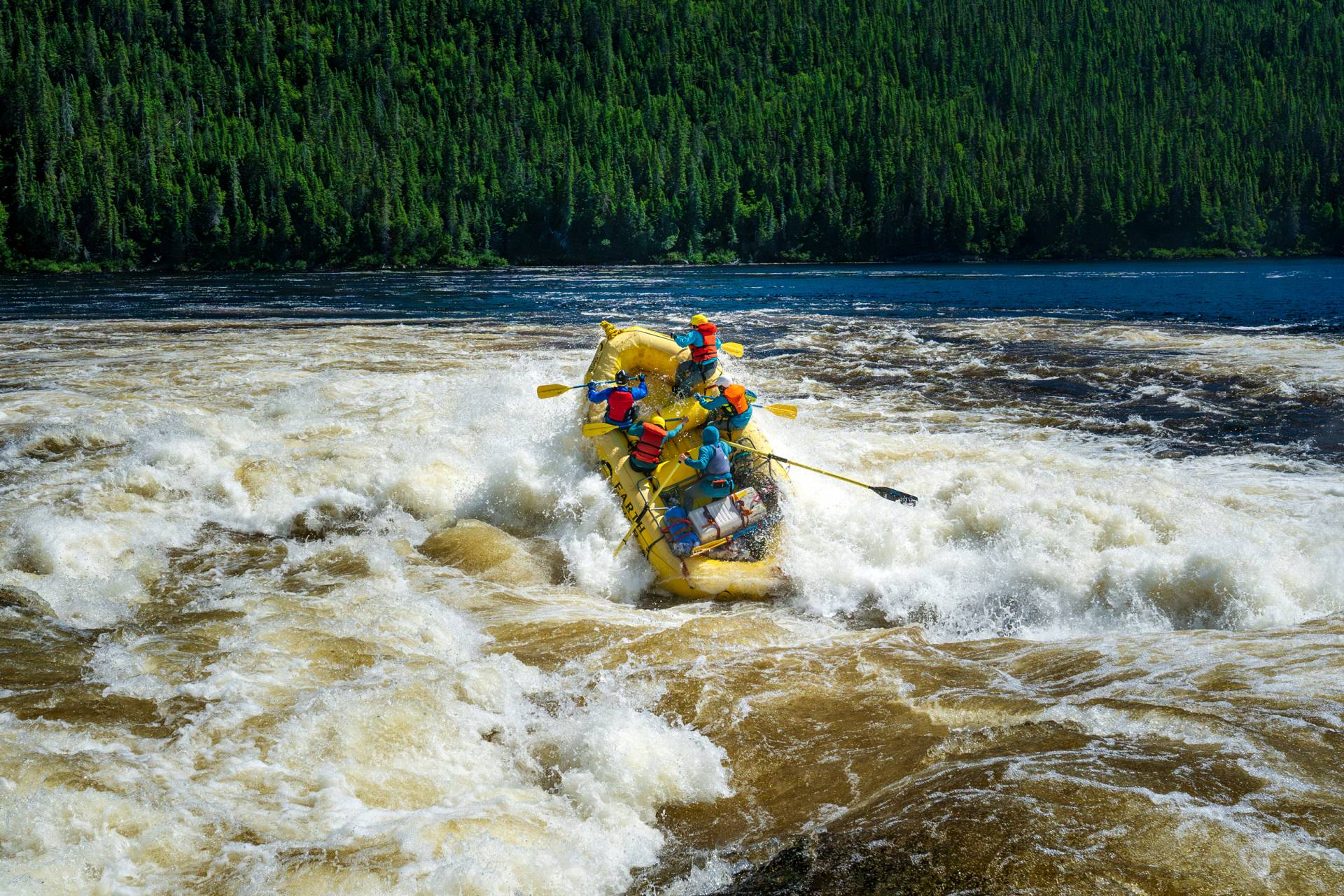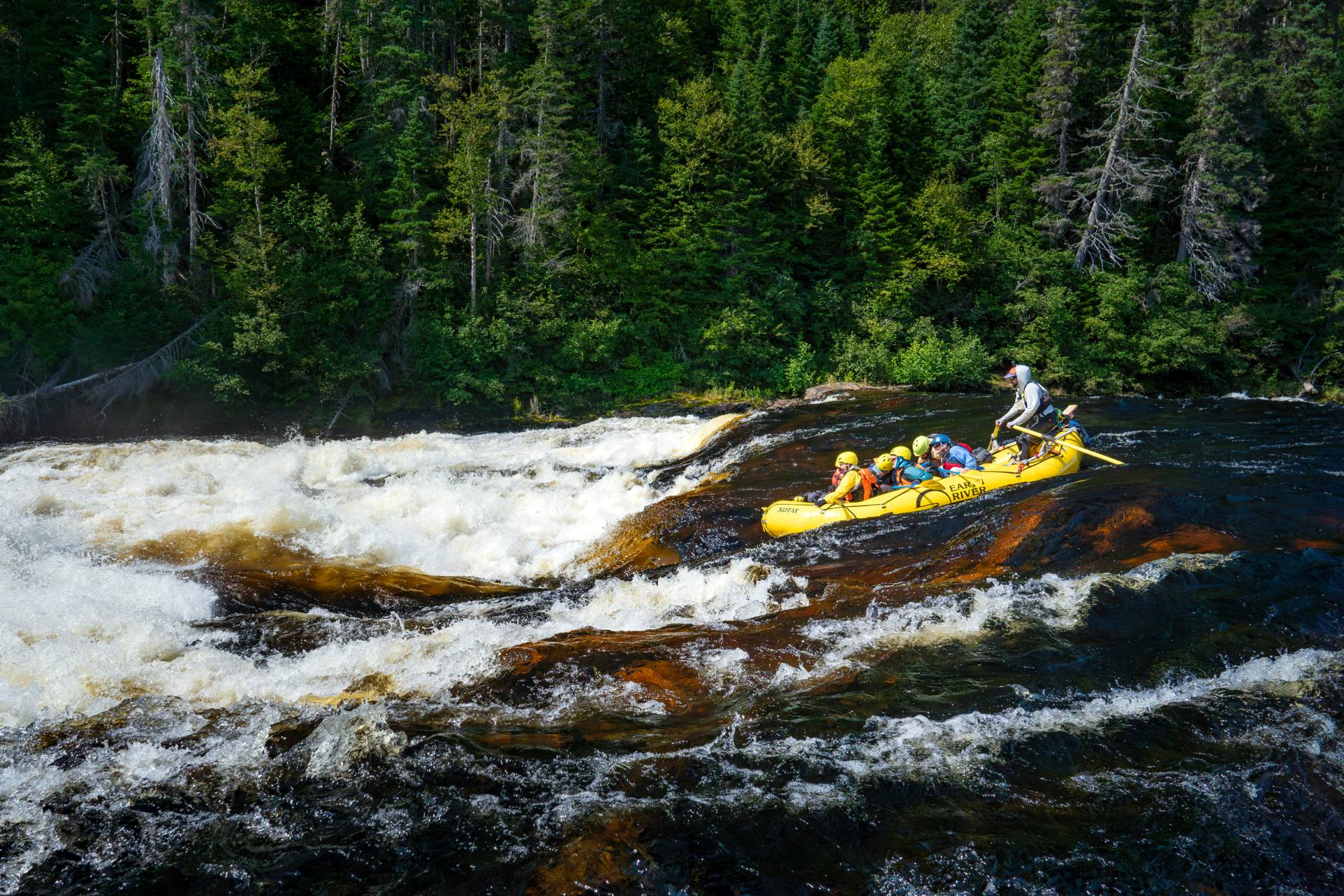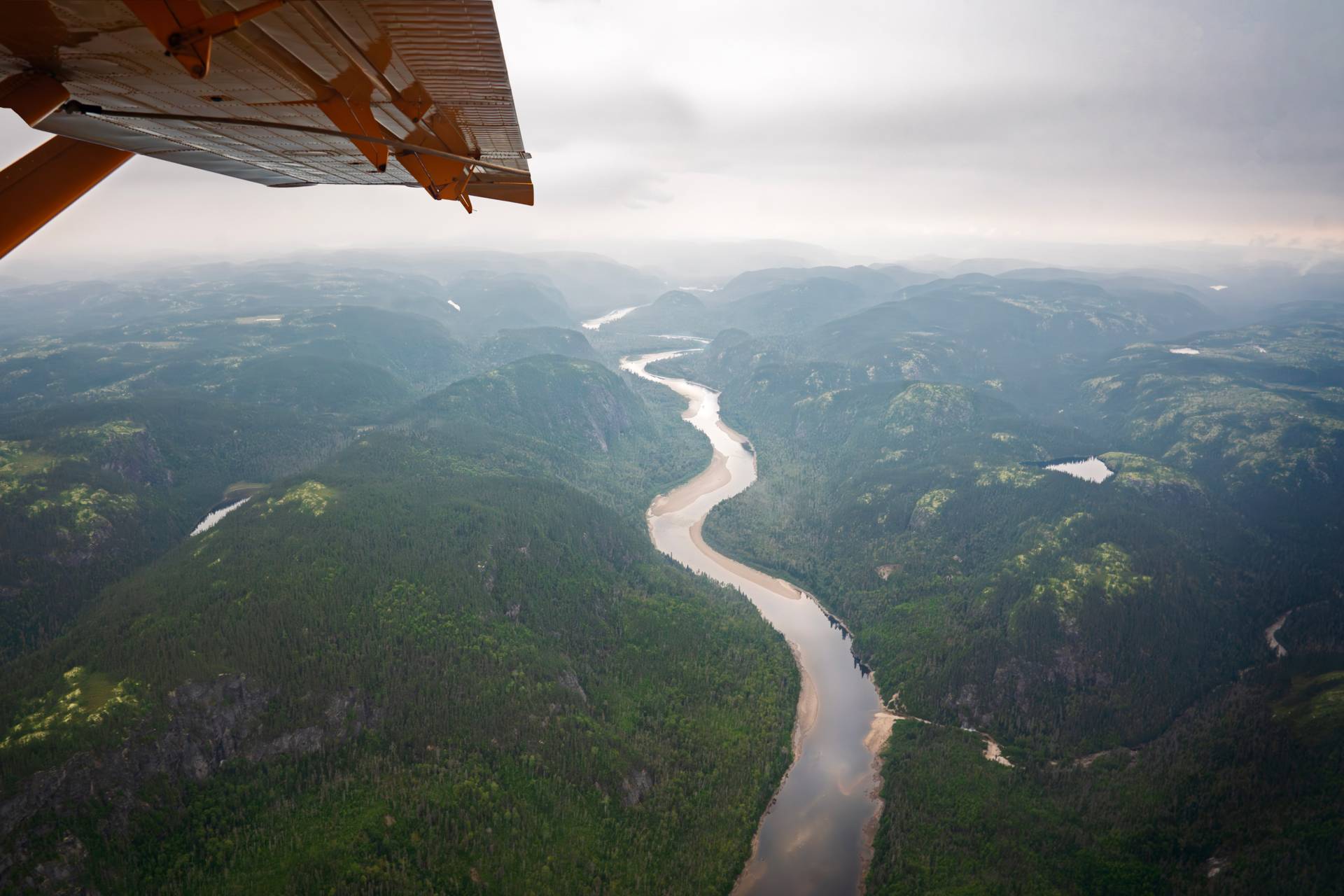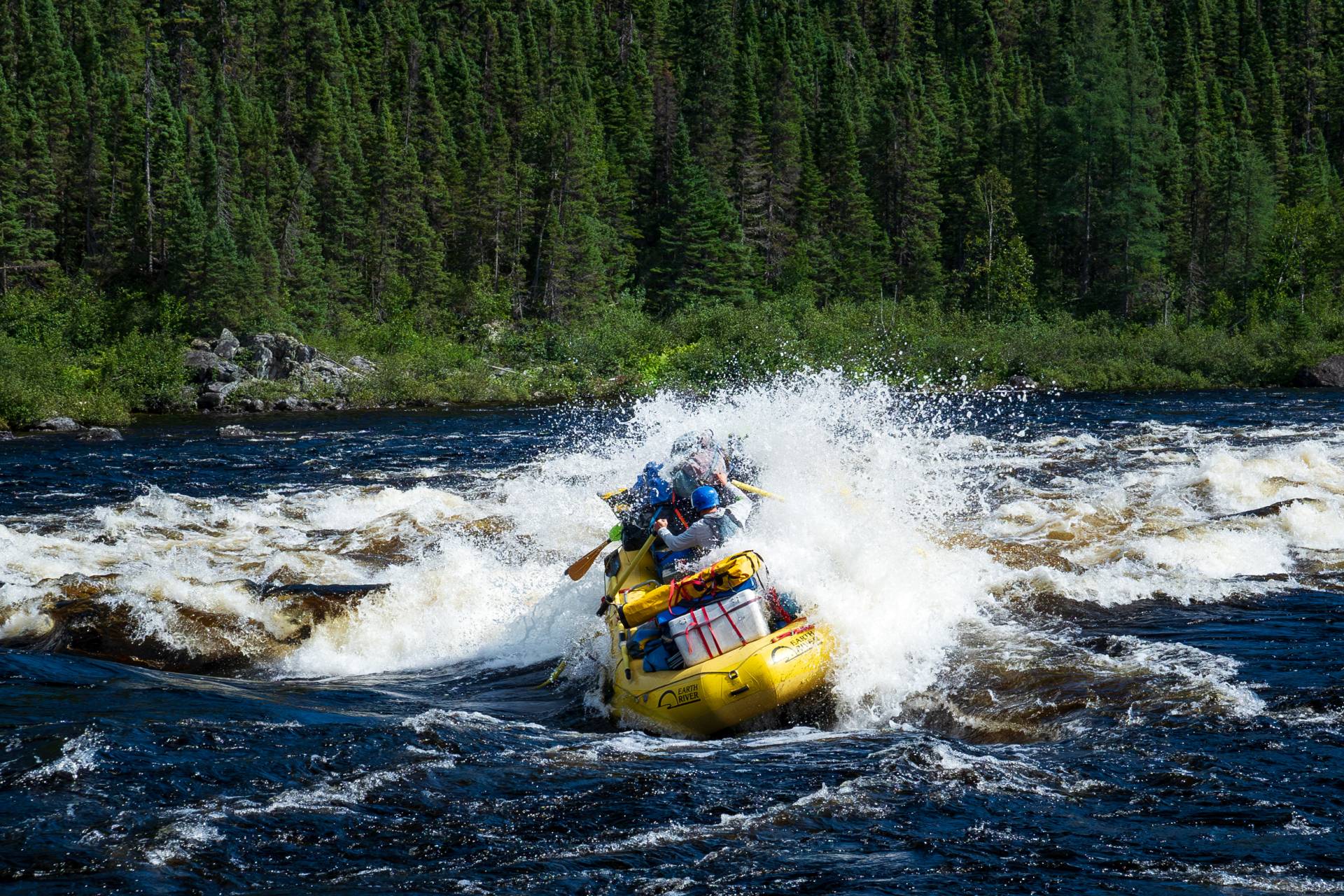The first two paddle rafts, followed by a baggage boat, dropped over the falls. A few hundred yards upstream, Sam, rowing the other baggage boat, watched in utter disbelief as the rafts ahead disappeared into a cloud of mist.
Changing rapids in mid-stream
This story began years earlier, when we were scouting the most difficult rapid on the Magpie. At the time, our trip down this wild river in Quebec featured dozens of wonderful, unnamed, fun, and exciting rapids, and one unusually difficult, out-of-character, and scary class V.

Located near the end of the river, the monstrosity is a maze of huge recirculating waves that must be threaded through a pushy, constricted channel. Even safely at the bottom of the rapid, your mind always seemed to back up at the top, knowing you’d be back the following week or year. For the clients whom the guides singled out to walk around the rapid for their own safety due to age or fitness, the experience marred what had been up to that point a wonderful vacation.
After tensely scouting the line, I turned to run the rapid and noticed a smooth spout of water, as wide as a raft, sliding off a high ledge on the other side of our scout island. At nearly a story-and-a-half high, I had never considered it a viable option.
Rafts and waterfalls aren’t necessarily ideal dancing partners
Unlike single-person kayaks, people in rafts have a tendency to hit each other at the bottom of falls. I was only aware of a few waterfalls being run commercially: a violent 21-footer on a Disneyland-like one-mile jaunt in New Zealand, and Sweets Falls on the Gauley River in West Virginia. Like Sweets, the Magpie cascade was a steep slide rather than a sheer drop. There was a large, angled curling wave at the bottom, which looked like it might give you trouble if you hit it wrong. We decided to test it with a baggage boat. The guide lined up perfectly, tucked his oars, and dropped off. The heavy boat had so much momentum when it hit the curler that it was vaulted into the air before landing safely downstream.
Baggage boats are a lot heavier than paddle rafts, and I wasn’t sure what would happen to us. In the eddy, my crew practiced a series of “get down” drills and holding on to the perimeter line, which would keep them in the boat. The plan was to paddle to the edge, turn the boat slightly to the right to match the angle of the downstream curler, and get everyone down.
As we ferried into the current, all I could see was spray rising from the vanishing river. We dropped off the lip to a chorus of wild screams. Like it had done to the baggage boat, the curler at the bottom effortlessly tossed us safely downstream. The guests were ecstatic as high-fives erupted. Eliminating our nemesis, with a beautiful, safe water slide, changed the whole trip. In addition to safety considerations, it was no longer necessary to divide the group into those who were able to run the rapid and those who were not. Someone suggested calling it “Savior Falls.” I was content to refer to it as the “sneak route around the class V.” Eventually, names find rapids.
 Years later, a young Magpie baggage boatman, barely twenty, would contribute to its naming. Sam was from Colorado and the nephew of a guide who had worked for us on the Magpie in earlier years. He was a talented rower, but his people skills were lacking.
Years later, a young Magpie baggage boatman, barely twenty, would contribute to its naming. Sam was from Colorado and the nephew of a guide who had worked for us on the Magpie in earlier years. He was a talented rower, but his people skills were lacking.
There are five wonderful, exhilarating rapids before lunch the first day on the Magpie. We pulled over at a granite island covered in moss and thick bluish-green reindeer lichen. People were animated about the rapids, especially the last one that ended with a giant wave, when, out of the excitement, Sam announced:
“These rapids are a lot easier than I thought. My uncle said the Magpie’s got great whitewater, like the ‘Numbers’ on the Arkansas. I don’t know what he was talking about. This river’s a laugher.” The group suddenly grew quiet, their whitewater accomplishments from the morning diminished. “Even the last one with that nothing wave at the bottom, “ Sam bulldozed on, oblivious to the group’s deflated reaction.
“Sam, come here,” I said, motioning him away from the group. “Look, Sam, let’s not compare rapids or rivers in front of the guests, okay?”
“Oh, sorry about that, Eric. I was just kind of surprised. The way my uncle talked. So far, everything’s read and run.”
“Read and Run” is a whitewater term used to describe running an unfamiliar rapid without scouting.
The guide crew had no patience for immature, egocentric guides. Unfortunately, every now and then, a baggage boatman hired for a single trip would slip through the cracks.
Although Sam refrained from making any more river comparisons in front of the guests, they always seemed to crop up during meal preparation among the guides. On the fourth night, we were setting up the kitchen after a long day when Sam blurted out, “I think my uncle was just trying to scare me. Thinks I’m cocky. I mean, we’ve been scouting things up here you’d never even consider looking at out West. Don’t get me wrong, Eric, this is a beautiful place. I was just expecting a little more.”
“Why don’t you wait until tomorrow?” I suggested. “You’ve got the four biggest rapids.”
“Yeah, but they’re just more ‘read and run,’ right?” Sam said as he walked off to set up the porta-potty.
Sam’s constant river comparisons and ego were really starting to affect guide morale. So much so, in fact, that one of the guides suggested running the 14-foot unnamed falls without scouting, just to teach him a lesson. We always scouted the 14-foot unnamed falls, not because it was necessary, as the route was straightforward, but so we could explain the route to the guests and ease their fears. It looked a lot more intimidating than it was. With the water flowing cleanly over in just that one spot, it was nearly impossible to mess up.
Sam had mentioned that, in order to make rivers like the Magpie more challenging, he preferred to leave some space between him and the boat in front so he could read the water himself. Below every rapid we didn’t scout he would yell, “Yee-haw! Read and run, baby! Nothing like acing rapids cold!” This drove the other guides crazy. We scouted the bigger rapids, so I was okay with him hanging back.
The Day the Falls Found a Name
“Eric, what’s this coming up?” one of the guests asked me as we floated towards the unnamed falls.
“The really great water slide I mentioned earlier.
“No name?”
“No name. Everyone, remember the ‘get down command’ we practiced this morning?”
“It looks really big.”
“O.K., everyone, let’s get down!” I called out as we dropped off the edge to a chorus of wild whoops and squeals. At the bottom, everyone was thrilled and exchanged high-fives with their paddles. We pulled over to shore, tied up, and got out to watch Sam, who was lackadaisically floating with his feet up on the adjacent cooler a few hundred yards upstream.
Suddenly, he stood up on his seat for a better view. He plopped back down and started furiously rowing upstream to catch a patch of still water on the left shore above the falls. He tied up the raft and walked over for a closer look. From below, we watched him repeatedly use his hand to mimic the boat, his mind testing different routes.
I remembered the first time I scouted these falls, wondering what the sideways twisting wave at the bottom would do to the boat. It wasn’t exactly “read and run” but the Magpie was finally giving Sam what he longed for, a challenge of sorts.
He got back in his boat, rowed to the edge, and dropped off.
“Great drop, huh.” one of the guides offered when Sam rowed over to our boats.
“Yeah, great drop,” Sam replied unenthusiastically.
That evening after dinner, Sam called an impromptu guide meeting.
“What the hell was that about this afternoon?” he asked, trying to hold it together. “Read and run my ass! I couldn’t see a damn thing down there, just the tree tops!”
“That’s all we could see,” one of the guides said.
“Yeah, except I’ve never been down here!” Sam shot back.
“Well, you had a great line,” I said, trying to diffuse the situation.
“Thanks, Eric,” he said, calming down. “It was awesome! A lot bigger than Sweets Falls on the Gauley. That thing have a name, Eric?”
“It does now.”
“What’s that?.
“Trust Falls,” I answered.
National Geographic Named the Magpie “One of the Top 10 White-Water Rafting Rivers”
Although many of the Magpie’s two dozen rapids are now named, the river remains just as remote and wild as it was in 1989, when Earth River first explored it. It is the only multi-day whitewater rafting expedition east of the Mississippi and one of the most remote river trips in North America. Accessible only by helicopter or floatplane, the river is so isolated that we never see another group. Sections of the river are ideal for inflatable kayaking, and wetsuits are unnecessary in the relatively warm water. The final two nights are spent at camps that are among the most beautiful river locations in the world, and two of the trip’s highlights, along with ‘Trust Falls.”
By Eric Hertz


